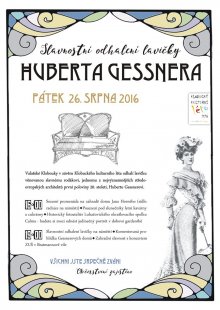
Moravian native Gessner gained fame for his buildings in the style of Art Nouveau and modernism
Prague - Architect Hubert Gessner, who became famous for his buildings in the Art Nouveau and Modern styles, is considered one of the most significant Central European architects of the first half of the 20th century. His buildings can be found in several Moravian and Silesian cities, as well as in Vienna. He also played a significant role in shaping the appearance of his hometown - the town of Valašské Klobouky. It has now prepared a special tribute for him by unveiling Gessner's bench in the town square, from which there is a view of his significant buildings.
Gessner was born on October 20, 1872, in a family of dyers from Valašské Klobouky. He studied at a technical school in Brno and later continued his studies at the Academy of Fine Arts in Vienna under Professor Otto Wagner. He realized his first works already during his studies, including for the Viennese brewer and native of Klobouky, Josef Bratmann, and also for the mayor of Klobouky, Franz Bratmann, for whom he designed a residential house combined with a weaving workshop. After his studies, he worked in Wagner's studio and also began collaborating with his classmates Alois Ludwig and Otokar Bém, and especially with his younger brother Franz, who also studied at the Vienna Academy.
From 1900 to 1906, he worked for the regional building office in Brno. During this time, he designed, for example, the headquarters of the District Health Insurance Fund, the central city baths, and an extension of a sanatorium. Among his significant buildings from that time is the Kroměříž Regional Institute for Treating the Mentally Ill, including the institutional church of St. Cyril and Methodius.
As one of the first architects in Central Europe, he began to lean towards geometric modernism, which was reflected, for example, in the Silesian House Hotel in Opava and the Jindřichův dvůr Hotel in Nový Jičín. In his hometown, he designed, for instance, the house of wealthy merchant Jan Horný, the Sun House, and the house of František Růžička. His workshop also produced many industrial buildings.
In Vienna, he is credited with the building of the publishing house with a printing plant Vorwärts, and among city parks on Sternwarterstrasse, he built his own villa. After the First World War, he became the chief architect for residential construction in Vienna. During this time, the residential complexes Karl-Seitz-Hof and Reumannhof were created according to his designs. After the occupation of Austria by Nazi Germany in 1938, he was banned from working. He died on April 24, 1943, in Vienna. His work inspired and influenced many other architects.












